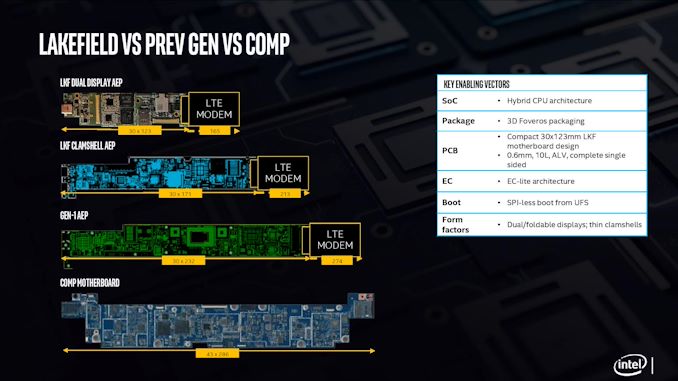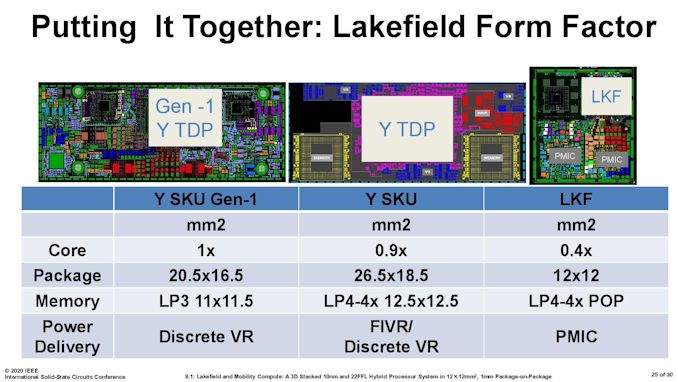The Intel Lakefield Deep Dive: Everything To Know About the First x86 Hybrid CPU
by Dr. Ian Cutress on July 2, 2020 9:00 AM ESTLakefield in Terms of Laptop Size
In a traditional AMD or Intel processor designed for laptops, we experience two to eight processing cores, along with some graphics performance, and it is up to the company to build the chip with the aim of hitting the right efficiency point (15 W, or 35/45 W) to enable the best performance for a given power window. These processors also contain a lot of extra connectivity and functionality, such as a dual channel memory controller, extra PCIe lanes to support external graphics, support for USB port connectivity or an external connectivity hub, or in the case of Intel’s latest designs, support for Thunderbolt built right into the silicon without the need for an external controller. These processors typically have physical dimensions of 150 square millimeters or more, and in a notebook, when paired with the additional power delivery and controllers needed such as Wi-Fi and modems, can tend towards the board inside the system (the motherboard) totaling 15 square inches total.

One of Qualcomm’s examples from 2018
For a Qualcomm processor designed for laptops, the silicon is a paired down to the essentials commonly associated with a smartphone. This means that modem connectivity is built into the processor, and the hardware associated with power delivery and USB are all on the scale of a smartphone. This means a motherboard designed around a Qualcomm processor will be around half the size, enabling different form factors, or more battery capacity in the same size laptop chassis.
With Intel’s new Lakefield processor design, the chip is a lot smaller than previous Intel implementations. The company designed the processor from the ground up, with as much included on the CPU as to not need additional chips on the motherboard, and to fit the dimensions similar to one of Qualcomm’s processors. Above is a slide showing how Intel believes that with an LTE modem included, a Lakefield motherboard can move down to 7.7 square inches, similar to a Qualcomm design. This leaves more room for battery inside a device.
When Intel compares it against its own previous low power CPU implementations, the company quotes a 60% decrease in overall board area compared to its first generation 4.5 W processors.
It is worth noting that for power delivery, Intel placed MIMCAPs inside the Lakefield silicon, much like a smartphone processor, and as a result it can get by on the power delivery implementation with a pair of PMICs (power management ICs). The reason why there is two is because of the two silicon dies inside – they are controlled differently for power for a number of technical reasons. If each layer within an active stacked implementation requires its own PMIC, that would presumably put an upper limit on future stacked designs – I fully expect Intel to be working on some sort of solution for this for it not to be an issue, however that wasn’t implemented in time for Lakefield.
For those that are interested, Lakefield’s PMICs are under the codenames Warren Cove and Castro Cover, and were developed in 2017-2018.












221 Comments
View All Comments
Santoval - Saturday, July 4, 2020 - link
AVX2/512 is not the only bit that differentiates the Core series from Atom. If you only care about floating point performance then yes, that's their primary difference. AVX has nothing to do with integer code though.ProDigit - Friday, July 3, 2020 - link
Not a single program, other than benchmarks use it.Very few use avx 256 even...
I wonder why anyone would need it on a laptop, especially considering it's a server feat.
Meteor2 - Friday, July 3, 2020 - link
Not photo and video editing software?lefty2 - Friday, July 3, 2020 - link
Tremont doesn't support any version of AVX. So, that would cause a huge swath of software to operate very slow. AVX is used a lot more universally than you think - practically all games use it. All multimedia applications, photo editing software, etc, etc.dotjaz - Saturday, July 4, 2020 - link
Wrong, AVX2 is quite universal on any multimedia tasks. AVX512 is pointless.Samus - Saturday, July 4, 2020 - link
Clearly a first-gen product. Give it time.For my sake I hope this isn't a dud because Intel clearly invested billions into the thing and I own a lot of Intel stock lol.
neogodless - Thursday, July 2, 2020 - link
Why not rename them Core Hybrid Intel Processors? Makes a great initialism!eastcoast_pete - Thursday, July 2, 2020 - link
With this decision (no AVX), they should call it a "Crybid". Those relaxed marijuana laws in CA sure have unexpected repercussions, but answer the question "what were they smoking?".YB1064 - Thursday, July 2, 2020 - link
"The bottom chiplet contains the ‘peripheral’ components that are not as performance related, such as security controller, USB ports, and PCIe lanes. This is built on Intel’s cheaper 22nm manufacturing node."Surely they are not going to go back to 22nm? The packaging engineering is interesting enough, but there seems to be no fundamental architecture improvements. I see Zen-xx crushing this straight out the gate. Definitely not adaptable for desktop use.
III-V - Thursday, July 2, 2020 - link
>I see Zen-xx crushing this straight out the gate. Definitely not adaptable for desktop use.This is a 7W processor, dumbass.